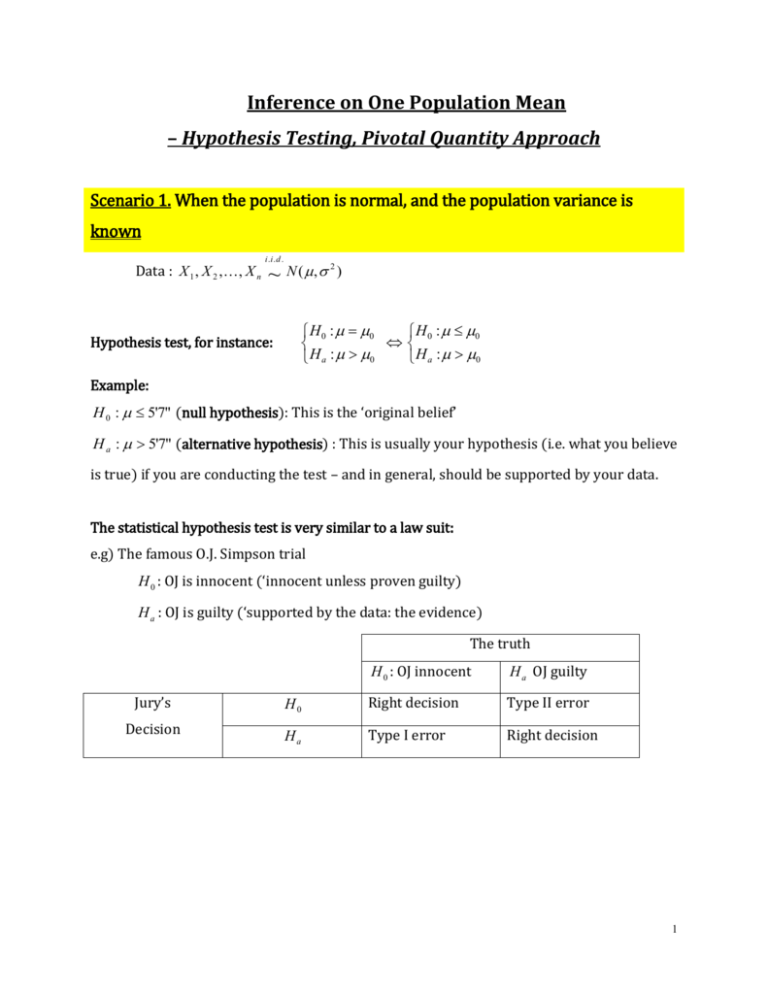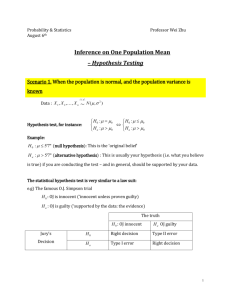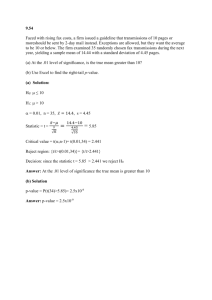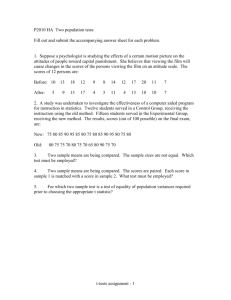AMS 572 Lecture Notes
advertisement

Inference on One Population Mean – Hypothesis Testing, Pivotal Quantity Approach Scenario 1. When the population is normal, and the population variance is known i .i . d . Data : X 1 , X 2 , , X n ~ N (, 2 ) H 0 : 0 H 0 : 0 H a : 0 H a : 0 Hypothesis test, for instance: Example: H 0 : 5'7" (null hypothesis): This is the ‘original belief’ H a : 5'7" (alternative hypothesis) : This is usually your hypothesis (i.e. what you believe is true) if you are conducting the test – and in general, should be supported by your data. The statistical hypothesis test is very similar to a law suit: e.g) The famous O.J. Simpson trial H 0 : OJ is innocent (‘innocent unless proven guilty) H a : OJ is guilty (‘supported by the data: the evidence) The truth Jury’s Decision H 0 : OJ innocent H a OJ guilty H0 Right decision Type II error Ha Type I error Right decision 1 The significance level and three types of hypotheses. P(Type I error) = α ← significance level of a test (*Type I error rate) 1. H 0 : 0 ⇔ H a : 0 H 0 : 0 H a : 0 2. H 0 : 0 ⇔ H a : 0 H 0 : 0 H a : 0 3. H 0 : 0 H a : 0 Now we derive the hypothesis test for the first pair of hypotheses. H 0 : 0 H a : 0 iid Data : X 1 , X 2 ,, X n ~ N ( , 2 ), 2 is known and the given a significance level α (say, 0.05). Let’s derive the test. (That is, derive the decision rule) Two approaches (*equivalent) to derive the tests: - Likelihood Ratio Test - Pivotal Quantity Method ***Now we will first demonstrate the Pivotal Quantity Method. 1. We have already derived the PQ when we derived the C.I. for μ Z X n ~ N (0,1) is our P.Q. 2. The test statistic is the PQ with the value of the parameter of interest under the null hypothesis ( H 0 ) inserted: Z0 X 0 n H0 ~ N (0,1) is our test statistic. That is, given H 0 : 0 in true Z 0 X 0 n ~ N (0,1) 2 3. * Derive the decision threshold for your test based on the Type I error rate the significance level (1) For the pair of hypotheses: H 0 : 0 Versus H a : 0 It is intuitive that one should reject the null hypothesis, in support of the alternative hypothesis, when the sample mean is larger than 0 . Equivalently, this means when the test statistic Z 0 is larger than certain positive value c - the question is what is the exact value of c -- and that can be determined based on the significance level α—that is, how much Type I error we would allow ourselves to commit. Setting: P(Type I error) = P(reject H 0 | H 0 ) = P( Z 0 c | H 0 : 0 ) We will see immediately that c z from the pdf plot of the test statistic below. ∴ At the significance level α, we will reject H 0 in favor of H a if Z 0 Z 3 Other Hypotheses (2) H 0 : 0 H a : 0 (one-sided test or one-tailed test) Test statistic (same): Z 0 X 0 ~ N (0,1) / n P( Z 0 c | H 0 : 0 ) c Z (3) H 0 : 0 H a : 0 (Two-sided or Two-tailed test) Test statistic (same): Z 0 X 0 ~ N (0,1) / n P(| Z 0 | c | H 0 ) P(Z 0 c | H 0 ) P(Z 0 c | H 0 ) 2 P( Z 0 c | H 0 ) 2 P( Z 0 c | H 0 ) c Z 2 4 Reject H 0 if | Z 0 | Z 2 4. We have just discussed the “rejection region” approach for decision making. There is another approach for decision making, it is “p-value” approach. *Definition: p-value – it is the probability that we observe a test statistic value that is as extreme, or more extreme, than the one we observed. H 0 : 0 H 0 : 0 H 0 : 0 H a : 0 H a : 0 H a : 0 Observed value of test statistic Z 0 X 0 n H0 ~ N (0,1) p-value p-value P( Z 0 z 0 | H 0 ) p-value P( Z 0 z 0 | H 0 ) P(| Z 0 || z 0 || H 0 ) 2 P( Z 0 || z 0 || H 0 ) (1) the area under N(0,1) (2) the area under N(0,1) (3) twice the area to the pdf to the right of z 0 pdf to the left of z 0 right of | z 0 | 5 (1) H 0 : 0 H a : 0 (2) H 0 : 0 H a : 0 6 (3) H 0 : 0 H a : 0 (*That is, the p-value is the sum of the two tail areas, or equivalently, the p-value is twice the upper tail area.) *** The way we make conclusions for the tests based on the p-value is the same for all pairs of hypotheses: We reject H 0 in favor of H a iff p-value 7 Scenario 2. The large sample scenario: Any population (*usually non-normal – as the exact tests should be used if the population is normal), however, the sample size is large (this usually refers to: n ≥ 30) Theorem. The Central Limit Theorem. Let X 1 , X 2 , , X n be a random sample from a X n N (0,1) . n population with mean and variance 2 , we have Z * Thus when n is large enough (n 30) , Z * When σ is unknown, (n 30) , Z X S n X ~ N (0,1) - by CLT. n ~ N (0,1) – by CLT and the Slutsky’s Theorem Therefore the pivotal quantities (P.Q.’s) for this scenario are: Z X X ~ N (0,1) or Z ~ N (0,1) n S n We use the first P.Q. if σ is known, and the second when σ is unknown. The derivation of the hypothesis tests (rejection region and the p-value) are almost the same as the derivation of the exact Z-test discussed above. H 0 : 0 H 0 : 0 H 0 : 0 H a : 0 H a : 0 H a : 0 Test Statistic Z 0 X 0 S n ~ N (0,1) Rejection region : we reject H 0 in favor of H a at the significance level if Z 0 Z Z 0 Z | Z 0 | Z 2 p-value P(| Z 0 || z 0 || H 0 ) p-value P( Z 0 z 0 | H 0 ) p-value P( Z 0 z 0 | H 0 ) (1) the area under N(0,1) (2) the area under N(0,1) (3) twice the area to the right of pdf to the right of z 0 pdf to the left of z 0 | z0 | 2 P( Z 0 || z 0 || H 0 ) 8 Scenario 3. Normal Population, but the population variance is unknown 100 years ago – people use Z-test This is OK for n large (n 30) per the CLT (Scenario 2) This is NOT ok if the sample size is samll. “A Student of Statistics” – pen name of William Sealy Gosset (June 13, 1876–October 16, 1937) “A Student of Statistics” – pen name of William Sealy Gosset (June 13, 1876–October 16, 1937) http://en.wikipedia.org/wiki/William_Sealy_Gosset “The Student’s t-distribution” X ~ tn 1 S/ n (Exact t-distribution with n-1 degrees of freedom ) P.Q. T Review: Theorem Sampling from the normal population Let X 1 , X 2 , , X n X ~ N ( , 2 1) 2) W i .i .d . n (n 1) S 2 2 ~ N ( , 2 ) , then ) ~ n21 9 3) X and S 2 (and thus W) are independent. Thus we have: T X S n ~ t n 1 Wrong Test for a 2-sided alternative hypothesis (use Z): Reject H 0 if |𝑧0 | ≥ 𝑍𝛼/2 Right Test for a 2-sided alternative hypothesis (use T): Reject H 0 if |𝑡0 | ≥ 𝑡𝑛−1,𝛼/2 (Because t distribution has heavier tails than normal distribution.) Right Test * Test Statistic T0 H 0 : 0 H a : 0 X 0 S n H0 ~t n 1 * Reject region : Reject H 0 at if the observed test statistic value |𝑡0 | ≥ 𝑡𝑛−1,𝛼/2 * p-value 10 p-value = shaded area * 2 Further Review: 5. Definition : t-distribution Z T W ~ tk k Z ~ N (0,1) W ~ k2 (chi-square distribution with k degrees of freedom) Z & W are independent. 6. Def 1 : chi-square distribution : from the definition of the gamma distribution: gamma(α = k/2, β = 2) 1 MGF: 𝑀(𝑡) = (1−2𝑡) 𝑘/2 mean & varaince: 𝐸(𝑊) = 𝑘; 𝑉𝑎𝑟(𝑊) = 2𝑘 Def 2 : chi-square distribution : Let Z 1 , Z 2 , , Z k i .i .d . ~ N (0,1) , k then W Z i2 ~ k2 i 1 Example Jerry is planning to purchase a sports good store. He calculated that in order to cover basic expenses, the average daily sales must be at least $525. Scenario A. He checked the daily sales of 36 randomly selected business days, and found the average daily sales to be $565 with a standard deviation of $150. Scenario B. Now suppose he is only allowed to sample 9 days. And the 9 days sales are $510, 537, 548, 592, 503, 490, 601, 499, 640. For A and B, please determine whether Jerry can conclude the daily sales to be at least $525 at the significance level of 0.05 . What is the p-value for each scenario? 11 Solution A large sample (⑤) n=36, x 565, s 150 H 0 : 525 versus H a : 525 *** First perform the Shapiro-Wilk test to check for normality. If normal, use the exact T-test. If not normal, use the large sample Z-test. In the following, we assume the population is found not normal – but since the sample size is large, we use the approximate Z test based on CLT & Slustky’s Theorem. Test statistic z0 x 0 565 525 1.6 s n 150 36 At the significance level 0.05 , we will reject H 0 if z0 Z 0.05 1.645 We can not reject H 0 p-value p-value = 0.0548 *** Alternatively, if you can show the population is normal using the Shapiro-Wilk test, it is better that you perform the exact t-test. Solution B small sample Shapiro-Wilk test If the population is normal, t-test is suitable. (*If the population is not normal, and the sample size is small, we shall use the non-parametric test such as Wilcoxon Signed Rank test.) In the following, we assume the population is found normal. 12 x 546.67, s 53.09, n 9 H 0 : 525 versus H a : 525 Test statistic t0 x 0 546.67 525 1.22 s n 53.09 9 At the significance level 0.05 , we will reject H 0 if t0 T8,0.05 1.86 We can not reject H 0 p-value What’s the p-value when t0 1.22 ? 13









